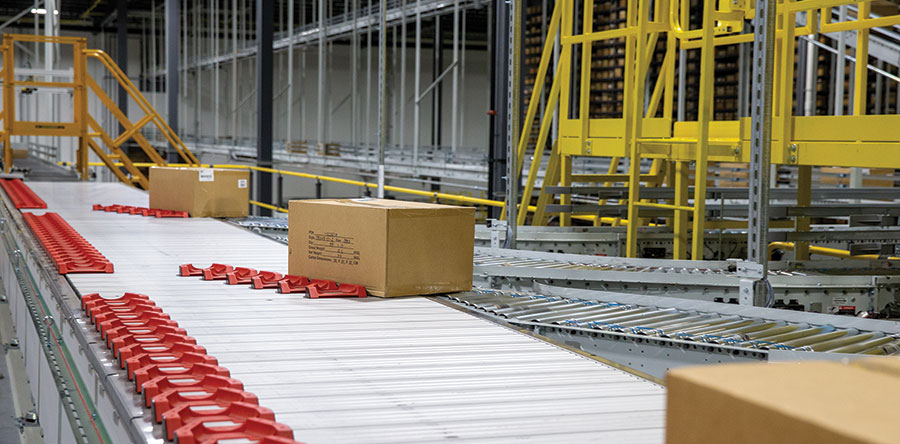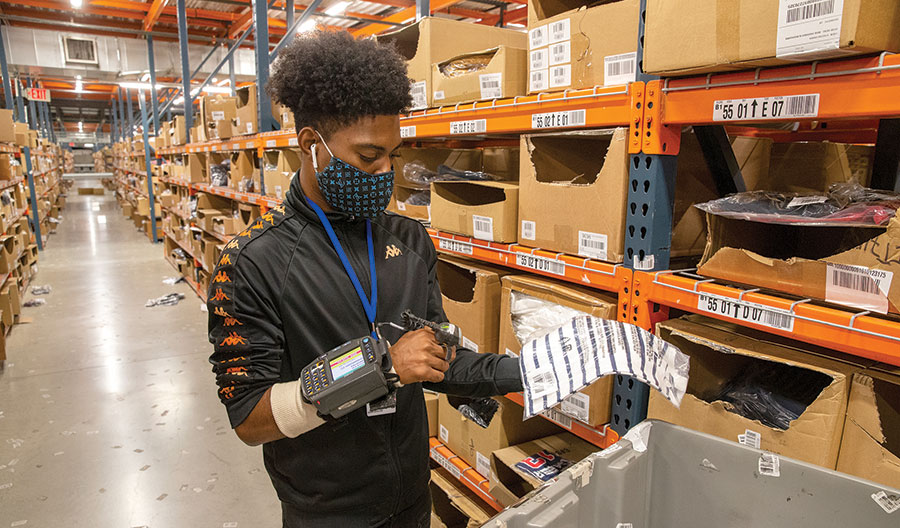Gap Inc.: Making resilience a core competency
The retail leader gave new life to an existing facility that sets the standard for e-fulfillment at Gap Inc. What’s more, it brought the 1.2-million-square-foot facility online two months ahead of schedule during a pandemic.
 We last visited with Kevin Kuntz, the senior vice president of global logistics fulfillment for Gap Inc., in November 2018. At the time, Kuntz was gearing up for the holiday season in a new facility in Gallatin, Tenn. The 500,000-square-foot e-fulfillment center was a showcase for the technologies and processes that Gap Inc. planned to roll out on a global basis, including dense storage using mini-load automated storage and retrieval, a handful of piece-picking robotic putwalls from Kindred AI and Vargo’s warehouse execution system.
We last visited with Kevin Kuntz, the senior vice president of global logistics fulfillment for Gap Inc., in November 2018. At the time, Kuntz was gearing up for the holiday season in a new facility in Gallatin, Tenn. The 500,000-square-foot e-fulfillment center was a showcase for the technologies and processes that Gap Inc. planned to roll out on a global basis, including dense storage using mini-load automated storage and retrieval, a handful of piece-picking robotic putwalls from Kindred AI and Vargo’s warehouse execution system.
Take a look at a detailed layout of the new distribution center.
But what really made the facility stand out was the story of how it came about. In August of 2016, just a few months before that year’s holiday season, Gap Inc.’s new 1-million-square-foot e-fulfillment center in Fishkill, N.Y., burned to the ground. That was the DC that was supposed to set the standard for e-fulfillment until it was destroyed. Undaunted, Gap Inc. got the Gallatin DC up and running in time for the 2016 holiday season and then improved upon it.
It was an illustration of resilience, a term that’s very much a part of the supply chain lexicon these days as we all grapple with Covid-19. Faced with a disruption, the best supply chain organizations quickly shift gears, take an unplanned detour and then get back on the original path. That’s what Gap Inc. did in Gallatin.
Fast forward two years, and we had another conversation with Kuntz shortly before the start of the 2020 holiday season. This one was about Gap Inc.’s 1.2-million-square-foot e-fulfillment center near Columbus in Groveport, Ohio.
On the one hand, it is the story of the rebirth of a mega center that sets a new standard for e-fulfillment. Gap Inc. added 400,000 square feet to an 800,000-square-foot facility it had been operating since 2001. The facility includes 14 miles of conveyor, 24 mini-load automated storage and retrieval system (AS/RS) cranes, a bomb bay sortation system, an extensive crossbelt sorter and 40 robotic putwalls—with plans to increase that to 60. It’s all tied together by the warehouse execution system (WES) that synchronizes processes in Gap Inc.’s facilities (Vargo).

At present, the facility is doing 600,000 units a day for Old Navy and Gap Inc., with plans to grow that to 1 million units a day using the bomb bay sorters. But, as with the Gallatin facility, Gap Inc. once again demonstrated that resilience is a core capability for its supply chain organization.
“We got the go-ahead for this project in 2019 with a goal to go live in July 2020,” Kuntz recalls. “But when Covid hit, we experienced a 100% growth in e-commerce in Q2 and realized that we had to accelerate our go-live plans.”
That kind of acceleration would have been a challenge under any circumstances. Covid-19 added a new dimension, given that Ohio imposed travel restrictions that limited Gap Inc.’s ability to bring key personnel on site.
Still, Kuntz’s team put the muscle memory developed in Gallatin to work and was able to complete testing of the systems, including the IT systems, in April and go live two months ahead of schedule in May 2020. “There’s no question that this facility will determine our network of the future,” Kuntz says.

What’s old is new again
Prior to this project, Gap Inc. was one of the most efficient apparel retailers. Given Gap Inc.’s heavy retail footprint, the network was initially optimized around its stores. But, as with all retailers, e-fulfillment and digital sales were a larger part of the picture, demanding new solutions, even before Covid. “Customer expectations have changed,” says Kuntz. “So, the journey we’re on is to be able to react quickly and deliver faster. And, then we needed more capacity to meet demand.”
If the company was going to continue to grow the digital side of its business, it had to expand those capabilities. The goal for what became the Groveport project, according to Kuntz, was straightforward: Create a highly automated distribution center capable of processing 1 million units per day, one that could then serve as a template for future Gap Inc. e-fulfillment DCs.
It was an ambitious goal. “One of the questions we asked was whether there was an apparel retailer doing 1 million units a day,” Kuntz recalls. “After looking for a long time, we found that no one was actually doing it.”
That meant Gap Inc. was creating a new template. To get there, they selected the Groveport facility. Built in 2001, it was ideally located near Columbus, a major logistics center for e-commerce distribution, and had served as Gap Inc.’s flagship e-commerce hub for nearly 20 years. At 800,000 square feet and capacity to handle 500,000 units a day, the processes and systems were similarly from the early 2000s. “We had a bunch of storage racks, a lot of lift trucks that we used to replenish the pick module and a tilt-tray sortation system,” Kuntz says. “And, we operated in a batch picking environment.”

But doubling capacity was going to require a major makeover. That’s because over time, the Groveport facility had been eclipsed by the other three e-fulfillment centers in Gap Inc.’s network, like Gallatin, where robotic putwalls had been rolled out several years earlier. A renovation would put the older facility back in the spotlight in the network.
Planning for the project began in 2018, funding was approved in 2019 with a go-live target of July 2020.

Design for scale
Kuntz says the design process was guided by Gap Inc.’s core operating principles.
- Keep it simple: “That’s No. 1,” Kuntz says. “We know we’re going to hire seasonal staff to get us through peak. If the design isn’t simple, training will be difficult.”
- Be efficient: “Working in a distribution center is challenging, so we always try to keep labor front and center in our design,” Kuntz notes. “We do everything we can so that the tasks aren’t too physically demanding.”
- Maximize storage: Gap Inc. facilities use automated storage and retrieval technologies, including mini-load AS/RS for carton storage, and very narrow aisle pallet storage.
- Make changes that are repeatable: To the extent possible, Gap Inc. uses a global platform, with a goal of rolling out common operating systems and proven technologies across the network. “During the design process, we looked at how can we incorporate tools we’ve already proved out in other facilities into Groveport,” Kuntz recalls. Robotic putwalls and a WES would be a prime example of this principle.
The design called for:
- Expanding the facility by 400,000 square feet to 1.2 million square feet.
- Double stacking the unit sorters and the shipping sorters to save space. “In a typical building, a sorter might take up 50,000 square feet and there’s nothing above it,” Kuntz explains. “By adding a mezzanine on top of the first sorter, we save 50,000 square feet of building.”
What’s more, he added, no one had built a single machine that could sort 1 million units in a 22-hour period, another reason to stack sorters. The technique was used for the unit sorter and for the shipping sorter. There are also multiple induction points for the unit sorter at either end of the shipping sorter.
- Building in redundancy. Although the shipping sorters are stacked on top of one another, they are both capable of hitting the same doors through a series of slides that lead to the loading belts. Similarly, if one unit sorter is down, the other can hit either shipping sorter.
- Reusing existing systems where possible. The design took advantage of two existing multi-level pick modules, and the conveyor system was re-worked so that instead of going to the old tilt tray sorter it now goes to the bomb bay unit sorters.
- Automating storage. The facility uses two stacks of 12 cranes to create a 24-aisle mini-load AS/RS for carton storage. Cranes manage both inbound and outbound processes.
- Hands-free where possible. Picking is RF driven on wearable scanning devices.
- Automating packing where possible. Single line orders are sorted to auto-bagging machines. Most multi-line orders are sorted to the robotic putwalls. The exceptions are orders that can’t be handled by the robotic grippers, which are sorted to a traditional putwall.
- Waveless. Finally, and perhaps most important, the facility implemented the WES system used in Gallatin to provide continuous order fulfillment cycle, or waveless picking. Rather than release a batch of orders to the floor, the WES is continuously dropping orders based on real-time conditions on the floor, smoothing out the workload. In addition, the system can prioritize orders based on expected delivery times and do so on a real-time basis. “If we get a hot order, we can drop it straight to the floor and complete it in 30 to 45 minutes,” Kuntz says. He added that Gap Inc. intends to roll the WES out in Canada next.
Coping with Covid
According to Kevin Kuntz, Gap Inc.’s head of global logistics fulfillment, two things happened when Covid-19 hit: Gap Inc. had to temporarily close its company owned and operated stores across North America; and, the other was that Gap Inc. experienced a 100% growth in e-commerce order volumes in the second quarter of the year.
One response to coping with the pandemic was to ramp up completion of the Groveport facility. But, that would take time and online demand was only rising. To pick up the slack, Gap, Old Navy and its other brands leaned heavily on their stores for fulfillment.
“Ship-from-store had been in our toolbox for more than five years,” says Kuntz. “So, we didn’t have to build that capability, and we now believe it will continue to be an important part of our future. At the end of the day, you have to meet the customer where and how they want to shop.”
In August 2020, Gap Inc. announced two new ways to shop, which were buy online/pickup in store (BOPIS) and curbside pickup for online orders. The new services were available at four brands: Gap Inc., Athleta, Banana Republic and Old Navy.
The offerings, which were piloted at two stores before the go-live, allowed customers to browse online and then, if the inventory was available in a local store, head into a store for pickup or choose contactless pickup, where a brand associate would bring the customer’s order to the trunk of their car. Orders were filled within two hours of being received.
According to Gap Inc., these services are now a permanent part of the customer experience mix.
Going live during Covid
The Gallatin facility went live during a time of crisis. Something similar happened in Groveport. When e-commerce orders suddenly spiked, Gap Inc. decided to bring the new operations online as fast as possible.
The idea all along was to continue to operate the existing processes while gradually bringing the new building online. Now, they had to move up the schedule while equipment was still being finalized and systems still had to be tested—and they had to do so while the state of Ohio was on lockdown and most businesses weren’t traveling.
Sub-contractors, partners and Gap Inc.’s own tech division stepped up to the plate to do their parts faster than anticipated, and under new working restrictions. Kindred AI, for instance, delivered its robotic putwalls on an accelerated schedule.
Another big challenge: How to test the IT systems, when the people who would normally do that job were in San Francisco and barred from traveling? The solution was to have two subject matter experts drive from Gallatin to Ohio in April. They, in turn, took their laptops on the floor and communicated with the technical resources in San Francisco over Zoom. “It was all remote testing,” Kuntz says.
One last hurdle to get over was to make all of this happen not just while outbound orders were spiking, but also while dealing with an unprecedented number of returns. During normal operating times, a portion of the returns go back to the stores, but with stores closed 100% of returns were coming to the facility. “We had to set up makeshift stations so that we could separate the returns process from the rest of the building,” Kuntz says.
Over a period of about six weeks, from mid-March through the end of April, new product was received into the new operation while the inventory in the existing system dwindled. That newly received inventory included PPE masks, which Gap Inc. shipped out by the tens of thousands during its test runs. By the first week of May, the system had gone live.
In early October, when Modern talked to Kuntz, he was gearing up for the kickoff of the 2020 holiday season with roughly five months of operational experience in the new building. There was more work to be done and various automation pilots were in the works. The facility at that time was processing 600,000 units a day—a 20% improvement over the old system—with a schedule to increase that to 1 million units in 2021.
“When we prove that we can do a million units a day from this site and balance the workflows to feed two 500,000 unit loops, Groveport will become the global platform for our other facilities,” Kuntz says. “That will allow us to chase what is now a digital dominant landscape.”
It also demonstrates that for Gap Inc., resilience is a core competency.

Article Topics
Automation News & Resources
Walmart chooses Swisslog AS/RS and software for third milk processing facility Lucas Watson appointed CSO for Körber’s Parcel Logistics business in North America 60 Seconds with Bob Trebilcock, outgoing executive editor, Modern Materials Handling Kathleen Phelps to join FORTNA as chief financial officer Coles automates grocery distribution in Australia 2024 Intralogistics Robotics Survey: Robot demand surges Warehouse automation extends life of cheese DC by a decade More AutomationLatest in Materials Handling
Registration open for Pack Expo International 2024 Walmart chooses Swisslog AS/RS and software for third milk processing facility NetLogistik partners with Vuzix subsidiary Moviynt to offer mobility solutions for warehouses Materials Handling Robotics: The new world of heterogeneous robotic integration BSLBATT is looking for new distributors and resellers worldwide Lucas Watson appointed CSO for Körber’s Parcel Logistics business in North America Hyster recognizes Dealers of Distinction for 2023 More Materials HandlingAbout the Author
Subscribe to Materials Handling Magazine

Find out what the world's most innovative companies are doing to improve productivity in their plants and distribution centers.
Start your FREE subscription today.
April 2024 Modern Materials Handling

Latest Resources












